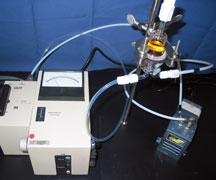
Chemical Permeation
Chemical protective clothing has been widely used to protect skin from health hazards that can be found in the workplace or during a terrorist attack. A new ASTM International standard provides directions in using a computer program, called a permeation calculator, to analyze data following a permeation test, in order to determine when chemicals have gotten inside the clothing.
The new standard, F2815, Practice for Chemical Permeation Through Protective Clothing Materials: Testing Data Analysis by Use of a Computer Program, was developed by Subcommittee F23.30 on Chemicals, part of ASTM International Committee F23 on Personal Protective Clothing and Equipment.
The computer program described in F2815 was developed at the National Personal Protective Technology Laboratory at the National Institute for Occupational Safety and Health.
"In the absence of the practice, data analyses for permeation testing of chemical protective clothing are performed in different manners, such as hand calculation or in-house developed methodologies," says Pengfei Gao, research physical scientist, National Personal Protective Technology Laboratory, NIOSH, and an F23 member. "It was found that the differences in hand calculation of breakthrough time could be up to 25 percent or more, raising a question if a clothing item can be worn for eight hours or less than six hours before skin is harmed from hazardous chemicals."
Gao also notes that calculations of some permeation parameters, such as standardized breakthrough time and cumulative permeation for an open-loop test, are mathematically complex and time-consuming without a computer program.
"The computer program provides a user-friendly tool for the data analysis," says Gao. "After importing a permeation data file, the program asks the user to enter required variables and information."
Once variables are entered, the program calculates all the permeation parameters related to the following:
ASTM F739, Test Method for Permeation of Liquids and Gases Through Protective Clothing Materials Under Conditions of Continuous Contact;
ISO 6529, Protective Clothing - Protection Against Chemicals - Determination of Resistance of Protective Clothing Materials to Permeation by Liquids and Gases; and
ASTM D6978, Practice for Assessment of Resistance of Medical Gloves to Permeation by Chemotherapy Drugs (if applicable).
The program performs these calculations in seconds rather than the hours required by hand calculation. Results are presented with relevant information and the permeation curve in a report file.
Gao says that industrial hygienists, researchers and college students involved in education or research in the chemical protective clothing field will be the primary users of the standards.
"Protective clothing manufacturers worldwide will benefit from F2815 since they must inform customers about reliable permeation parameters of their products in a consistent manner, and F2815 will allow them to do this," says Gao. "The practice will also help diagnostic laboratories and research centers involved in chemical protective clothing testing."
The computer program is available at no charge either on the NIOSH website (www.cdc.gov/niosh/npptl/PermeationCalculator/permeationcalc.html) or on CD by request to NIOSH.
To purchase ASTM International standards, visit www.astm.org and search by the standard designation number, or contact ASTM Customer Relations (phone: 610-832-9585).
CONTACT Technical Information: Pengfei Gao, NIOSH • Pittsburgh, Pa. • Phone: 412-386-6885 • Email: pgao@cdc.gov O ASTM Staff: Stephen Mawn • Phone: 610-832-9726 • Email: smawn@astm.org O Upcoming Meeting: Jan. 31-Feb. 2, 2012 • January Committee Week • Atlanta, Ga.
 SN Home
SN Home Archive
Archive Advertisers
Advertisers Masthead
Masthead RateCard
RateCard Subscribe
Subscribe Email Editor
Email Editor